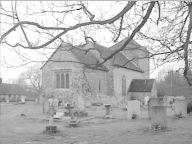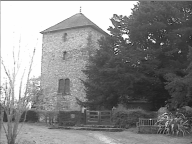![]()

![]()

25. St Mary the Virgin, Stopham
This most attractive church lies just north of the road from Petworth to Pulborough. Very strong and fortress like in appearance, especially the massive tower with its unusual wooden shutters on the belfry windows, St Marys would surely repel any invader. The original church dates from the eleventh century but has been much reconstructed since.
Inside, the timbered roof is most impressive whilst there is an unusual three sided pew near the lectern. The octangular font dates from the thirteenth century and is ornamented with Quatrefoils.
The glass is Victorian. In the north wall of the nave two windows commemorate Brian de Stopham and his son Ralph, two soldiers from the mid 13th century. Both are portrayed as kneeling knights. In the chancel there is a window commemorating Mary 'Blessed art thou among women' also Christ depicted holding a lamb.
But the whole church is dominated by memorials of the Bartellot family, owners of the Stopham Estate and Manor since the thirteenth century when John Bartellot became Treasurer to the Earl of Arundel. The continuity and history of the family over seven centuries is quite astonishing.
No fewer than 17 brasses along the floor of the nave and chancel commemorate sundry family members between 1428 and 1738. The East window portrays the arms of six Bartellot brothers of the seventeenth century, as does the West window halfway up the tower. Around the walls are innumerable memorials from the last two centuries. The family had a remarkable military tradition. Some of these are well worth quoting.

First, George Bartellot who died in 1872. As a young man he served in the Royal Horse Artillery in the Peninsular War winning five clasps. Then there is a fascinating epitaph to Major Edmund Musgrave Bartellot. He commanded the expedition sent to Africa in January 1887 in search of Stanley and the relief of Emin Pasha. He was 'treacherously shot at Unaria in Central Africa on 19 July 1888 by Senga a native maneyma carrier provided by Tippoo Tib'.
At the west end a brass commemorates Sir Walter George Bartellot a Major in the 2nd Battalion Royal Sussex Regiment who 'fell gallantly leading his men on July 23 1900 in the desperate assault on the Boer position at Retief's Nek'. Another beautifully engraved memorial is in honour of Sir Walter Balfour Bartellot DSO Lieutenant Colonel of the Coldstream Guards. Severely wounded on the Aisne in September 1914, he later served as General Staff Officer in Mesopotamia being present at the recapture of Kut and Baghdad in 1917. He died in October 1918 whilst Military Attache in Teheran.
Finally there is Sir Walter de Stopham Bartellot, who commanded the 6th Guards Tank Brigade in Normandy. After winning the DSO at the Battle of Caumont he was killed in action on August 16 1944. Over this memorial hang the Regimental Colours of the Coldstream Guards. What a slice of history is revealed by this one family who have given so much service and sacrifice for their country over the centuries.
Outside in the churchyard is a memorial to Vernon Lane Guise a former Rector, killed when his horse took fright and his carriage overturned. In his will he ordered all his horses and dogs to be killed and buried, with the horses wearing full harness. Somewhat reminiscent of an Egyptian Pharaoh?
Under the yew tree near the gate is a more discreet gravestone. Here lies buried a famous cricketer Arthur Gilligan, captain of Sussex and England in the 1920's.
Before driving home, if you feel exhausted after reading all these memorials why not visit the nearby River Arun at the seven arched Stopham Bridge where the excellent pub the White Hart awaits you?
John Symonds
![]() Return to the February 1999 Features page
Return to the February 1999 Features page
![]() return to Home page and main index
return to Home page and main index
page last updated 1 FEBRUARY 1999